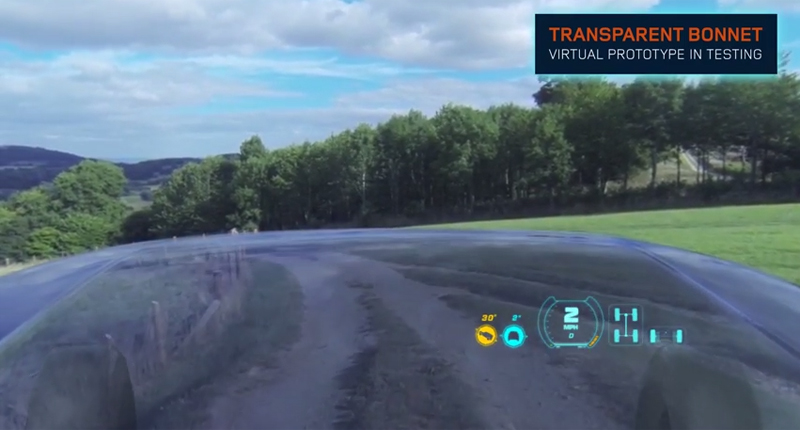Off-roading enthusiasts are typically a reserved bunch. They don’t do well with change, and thus generally aren’t fans of new-fangled gadgets.
To be fair, there’s a reason for this. When you’re crawling through the muddy middle of nowhere – without cellphone reception and with no manufacturer-approved mechanic for miles – and a component fails, you don’t want it to be something that relies on a complicated electronic system.
No ad to show here.
Instead, you hope it’s something you – a simple (yet ruggedly handsome) man – can fix. With your bare hands. And perhaps some duct tape. Or even a rusty length of chain.
But that hasn’t stopped automakers and other industry leaders from looking into the future of off-roading. Yes, we’ve got some bad news for the enthusiasts: your all-wheel drive vehicle is about to become even more complex.
1. The transparent bonnet
Augmented reality and off-roading. They go together like Coke and Mentos, right? Well, not according to Land Rover. The brand reckons its clever “transparent bonnet” concept has the potential to change off-roading for the better.
The system employs an army of cameras positioned at the front of the vehicle, which project a full-size image of the terrain ahead on the vehicle’s windscreen (which itself effectively functions as a massive head-up display).
In theory, this renders the vehicle’s bonnet transparent, affording the driver a perfect view of the terrain below. Negotiating narrow tracks or dealing with protruding rocks would no longer prompt nervous nail-biting.
2. The tyre of the future
Rubber’s rubber, right? Not exactly. Goodyear’s SUV concept tyre, for instance, is made up of two rings. The outer section comprises around two-thirds of the width and features a slick surface with cut-ins to move water and prevent hydroplaning on tarmac. But the inner ring, with its more aggressive tread, improves traction off-road. Handily, each ring has its own individual chamber, so a puncture needn’t be the end of the road.
Then there’s a nifty (possibly Bond-inspired) concept from Finnish firm Nokian Tyres. A retractable stud system allows studs embedded in the rubber to be deployed at the push of a button, instantly improving grip in nasty winter conditions.
Land Rover, in collaboration with Italian tyre-maker Pirelli, has a similar concept, which uses an electro-mechanical system to deploy small spikes moulded into the tyres. These tiny spears rise up above the surface of the tread on demand, making light work of snow and ice.
3. The electric powertrain
Yes, you read that correctly. Think about it: an electric off-roader actually makes a whole lot of sense (once battery technology has advanced far enough to banish range anxiety, that is). One of the things that virtually all effective off-roaders have in common is low-down torque. And electric motors, of course, can serve up instant peak torque from zero revolutions per minute. That’s some serious pulling power.
Of course, the idea has already been applied to small all-terrain vehicles, off-road motorcycles, side-by-side vehicles, and even some military vessels. They’re exceptionally quiet, produce no noxious gases, and may even be cheaper to run.
In fact, a Jeep engineer once described electric power as “perfect for rock-crawling, hill-climbing and hill-descent,” adding that engine braking in an electric vehicle “puts power back in the battery the whole way down the hill”. Adding an on-board generator in the form of an efficient diesel engine certainly wouldn’t hurt on long trips, either.
4. The remote control function
What do you do when the going gets really tough off-road? That’s right. You enlist the help of a spotter. But Range Rover reckons the off-roading enthusiast of the future will simply exit the vehicle, open an application on his or her smartphone, and negotiate that pesky obstacle with a few swipes of the finger.
Yes, the clever concept uses an app that allows the holder of the phone to steer, accelerate and brake the vehicle, as well as toggle between high- and low-range gearing. The remote control function works at a distance of up to nine metres, at speeds up to around six kilometres per hour.
Of course, the tech would be just as useful in a tight parking lot, particularly when the inconsiderate user of the vehicle alongside yours leaves you no room to clamber back into the driver’s seat. Admit it: you wish your car were remote-controlled…
5. The depth-sensing system
Yes, it’s another concept from the studious folks over at Land Rover. The company’s Wade Aid concept uses lasers to measure (or, to use the company’s preferred word, “predict”) the depth of water before the vehicle enters.
Wait, don’t some of the posher offerings from the British automaker already do that? Actually, the current systems – which use ultrasonic sensors fitted to the side-mirrors – provide the driver with “real-time information” on water depth, sounding a warning only when the vehicle’s maximum wading depth has pretty much already been reached.
Indeed, Land Rover warns that the currently available function “shouldn’t be used in extreme off-road driving, when the water depth might change too suddenly for the system to warn the driver in time”. If you ask us, we’d much rather know if the river we’re trying to drive across is too deep BEFORE we set off. And that’s where this concept clearly has the upper hand.
